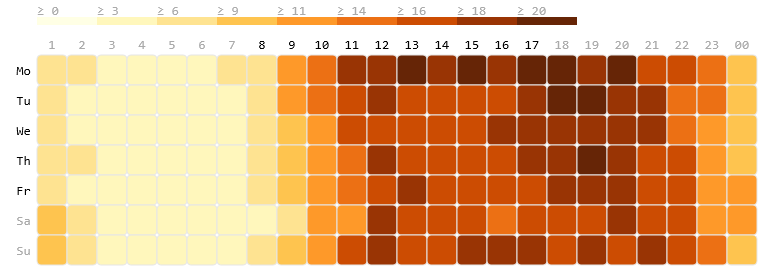Unlock a world of possibilities! Login now and discover the exclusive benefits awaiting you.
- Qlik Community
- :
- Forums
- :
- Groups
- :
- Industry and Topics
- :
- Healthcare
- :
- Visualizing the busy-ness
- Subscribe to RSS Feed
- Mark Topic as New
- Mark Topic as Read
- Float this Topic for Current User
- Bookmark
- Subscribe
- Mute
- Printer Friendly Page
- Feature this Topic
- Mark as New
- Bookmark
- Subscribe
- Mute
- Subscribe to RSS Feed
- Permalink
- Report Inappropriate Content
Visualizing the busy-ness
http://qlikdork.com/wp-content/uploads/2015/02/Boom.jpgNot that anyone would be surprised to discover a direct correlation between supply and demand but in my last post on “Visualizing Knowledge” the scatter plot proved to be a very advantageous chart type in that it showed there was a very distinct correlation between the two. On the busiest days (Monday) it took longer on average for a patient to transition from walking in the door to being placed in a bed. The scatter plot was a good visualization choice to help us quickly and effectively see the relationships by day of week.
The goal of this post is to try and drive deeper because while “day of the week” is a common unit of measure in reality that is a rather large unit of measure that is comprised of 24 individual hours. More specifically we want to find a way of visualizing the busy-ness hour by hour. Just for fun let’s challenge ourselves to provide what Albert Cairo refers to as the “boom” effect in his book “the functional art.” In simplest terms we want the graphic to show up as a visual pyrotechnic. I want our visualization to explode off the page into the readers mind.
The natural starting point I suppose would be a pivot table. It’s a simple way of visualizing a measurement like “# of people who walk in the door” across multiple dimensions like “Day of the Week” and “Hour of the Day.” Easy peasy right?
Easy peasy to create perhaps, but is it really so easy to read? A pivot table may be the perfect choice for multi-demension analysis when both dimensions have few values. But in this case we have 168 unique cells and it is all but impossible to spot any immediate patterns.
Fortunately I specifically indicated that we needed to provide a “boom” factor in our visualization or we might have been tempted to stop and simply say “look Mr. E. D. Director you asked to see 168 values and I showed them to you.” In his afore mentioned book “the functional art” Alberto Cairo spends a great deal of time explaining the science behind how we visualize anything as humans.
In one section he uses an image of what could be a pivot table and says “The brain is much better at quickly detecting shade variations than shape variations.” The point he was making is that its nearly impossible for humans to see that many numbers side by side and on top of each other and make them out. In the following try and find all of the 6’s:
4 3 6 9 1 6 5 7 8 2 4
9 8 4 6 3 2 1 9 5 3 1
7 2 8 1 4 5 9 6 7 3 1
2 4 1 5 6 8 1 4 2 5 3
He then shows an alternative image with the exact same sequence of numbers but uses shading and suddenly what we as humans can do is made abundantly clear:
4 3 6 9 1 6 5 7 8 2 4
9 8 4 6 3 2 1 9 5 3 1
7 2 8 1 4 5 9 6 7 3 1
2 4 1 5 6 8 1 4 2 5 3
Cairo immediately goes on in his book to describe the Gestalt theory that human brains don’t see patches of color and shapes as individual entities, but as aggregates. How can we take advantage of that? We need that kind of impact for Mr. E. D. Director. We want him to be able to immediately visualize the busy time periods but avoid all of the busy-ness of 168 cells with numbers.
You probably guessed that we don’t want to use a 168 slice pie chart.
Nor do we want to use a line chart with 7 different lines each with 24 points.
What we want is affectionately known as a heat map. 
There can be no mistaking the busiest hours across all 168 unique cells. There can be no mistaking the obvious patterns either.
You can read the entire article on my blog site by clicking this link
